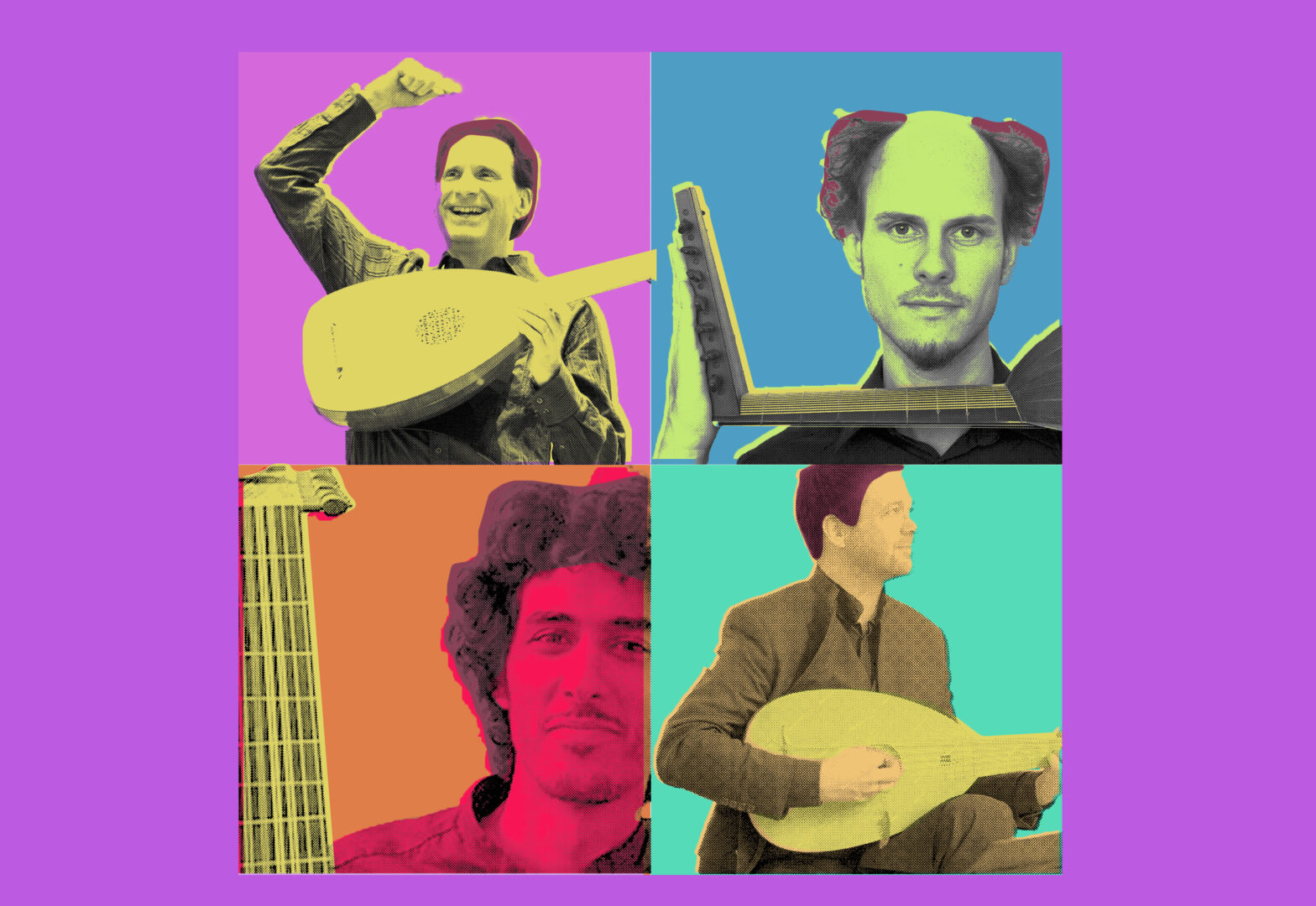
eRenaissance invites with four short programs of four Basel lutenists to the Wandelkonzert in four concert spaces of Gross- and Kleinbasel! And at the break, alternating between Gross- and Kleinbasel, there will be company with apero/coffee and cake in the original Renaissance room at the Hoher Dolder in St. Alban-Vorstadt. For once, ReRenaissance leaves the traditional Barfüsserkirche and invites a small circle of listeners at a time to listen in a “chamber” and share in the intimate setting.
A tour through the four stations allows visitors to experience the sound spectrum of one of the most popular instruments of the Renaissance: the plectrum-played lute of the 15th century as well as the finger plucked (or in the jargon of the time: “pinched”) sounds of the 16th century. Thereby solo lute pieces from sources of the late 15. until late 16th century interpreted, which often have a reference to Basel.
Organized in 4 different tours for max. 50 people. A tour guide will accompany you from there through the various stations.
Marc Lewon, Bor Zuljan, Peter Croton, Ziv Braha – lute
Management: Marc Lewon
For a description of the history of the Haus zum Hohen Dolder, see the “Texts and History” foldout.
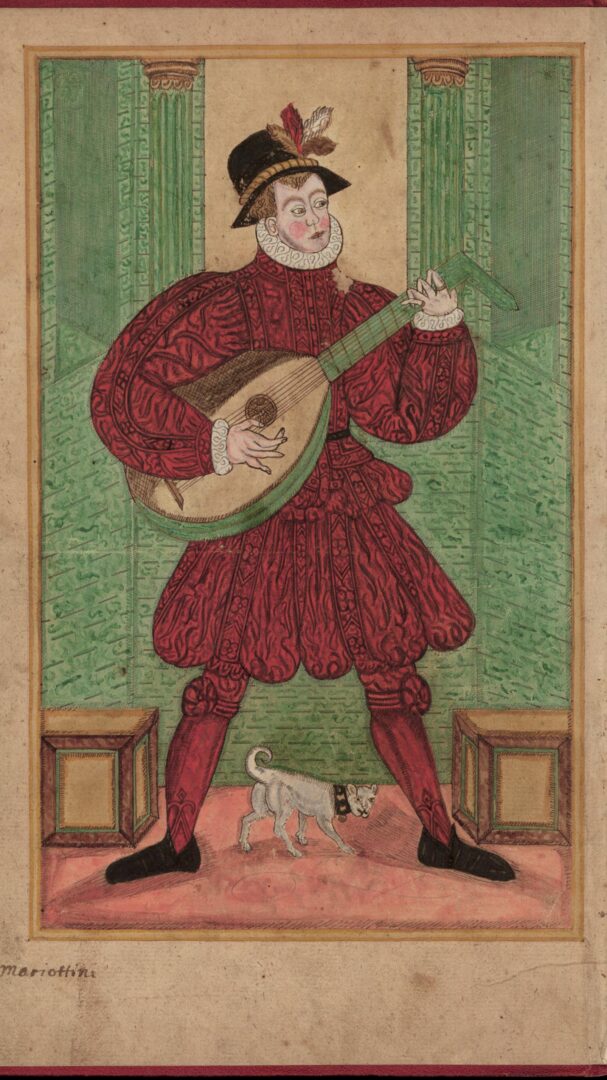
Image from phonetic tablature UB Basel F IX 39, 1575
VLOG on “Freshly Tweaked” -The Basel Lute Parcours/AbsoLuteLy
October 2022 With Grace Newcombe and Marc Lewon
“Myn trud gheselle” from the Wolfenbüttel phonetic tablature
Thomas Christ talks with lutenist Peter Croton, lecturer for lute, romantic guitar and basso continuo at the Schola Cantorum Basiliensis and at the Musikhochschule in Bern. President of the German Lautengesellschaft
TC: Dear Peter Croton, We are pleased to invite renowned lutenist and author Peter Croton to our October interview. The first question: how do you go from playing the guitar in an American jazz formation to playing the lute in early European music? One learns from your resume that you gained stage experience in the U.S. as a teenager, as a singer and as a folk guitarist.
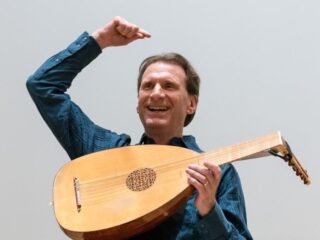
{%CAPTION%}
PC: I don’t sense any boundaries between different styles, but rather blurred contours: early music, serious music (with the exception of atonal music), folk music, jazz and film music all have the common denominator that harmony and melody and the interplay between consonance and dissonance touch the human soul and move it to various “passions” such as joy, love, fear, melancholy, longing etc. The journey from jazz guitar to early music was short: both are about moving yourself and others through the wonder of acoustic vibrations, with improvisation playing a big part.
TC: The early contact with the world of jazz leads me to the question of improvising, an art of early music that is hardly in demand anymore in classical music. Is this discipline somewhat forgotten today? Or is improvisation still cultivated at the SCB but hardly ever offered in the concert hall?
PC: Improvisation was as common in Renaissance and Baroque music as it is in jazz today. Although many great composers of serious music were still known as improvisers until the 19th century, this tradition has been largely lost today. Performances of early music in the 21st century, however, often include improvisation; not least, the art of basso continuo (the creation of a complete accompaniment from a bass line) thrives on improvisation. The Schola Cantorum Basiliensis is a leading force in the exploration of all aspects of improvisation in early music.
TC: You wrote manuals, tutorials on playing guitar, lute and theorbo a few years ago (2015/6). Maybe you can tell us something about the historical sources. How much do we learn from pictures, how much from didactic descriptions? – Sound sources do not exist …
PC: We need to study early sources such as writings and iconography, although didactic books in the modern sense hardly exist. However, there is a vast amount of information available, and although we will never know exactly how the music was played, we can come close to understanding the priorities of the time. A key to the performance of music of the Baroque period is rhetorical expression. The way this was implemented varied from era to era and from place to place, but regardless of differences in national style, rhetoric was the driving force.
TC: You are also active as a composer and set texts by Shakespeare to music – do you orient yourself on compositional patterns of the late Renaissance? Are there role models?
PC: I have written many songs in different styles, influenced by folk, jazz, early music and modern classical. My Shakespeare settings, for example, are written in a modern classical style, but influenced by the text-oriented priority of the early Baroque.
TC: The world of baroque music has enjoyed great popularity – also on opera stages – for several decades. In contrast, the extremely rich music of the Renaissance still tends to have a niche existence. Is this music too quiet, too intimate, too contemplative, too foreign – do you have an explanation for this or are there still golden times ahead for Renaissance music?
I think that baroque music attracted more public attention because of its harmonic orientation. The influence of acoustic vibrations on our feelings is a general experience that does not depend on knowledge of harmony or the rhetoric of connection to intervals and chords. Baroque music, oriented around the interplay of dissonance and consonance, reflects well the interplay of tension and relaxation that we experience in daily life. In Baroque terminology, one might say that consonance soothes the soul and dissonance excites it. On the other hand, Renaissance polyphony, for example, follows strict rules that limit the rhetorical effect of tension and release and the expression of the text. Besides, there is a modern tradition of performing Renaissance music in a rather quiet way. I believe that Renaissance music will find a larger audience as we better understand its inherent expression.
Long before the invention of portable players (to be used here depending on the age category: Suitcase radio, Walkman, MP3 player or cell phone with Spotify subscription) it was from the middle of the 15th century excellently the lute, which made music transportable for everyone (- for women, however, seems to have been more appropriate a bulkier keyboard instrument, which also tied them better to the house). 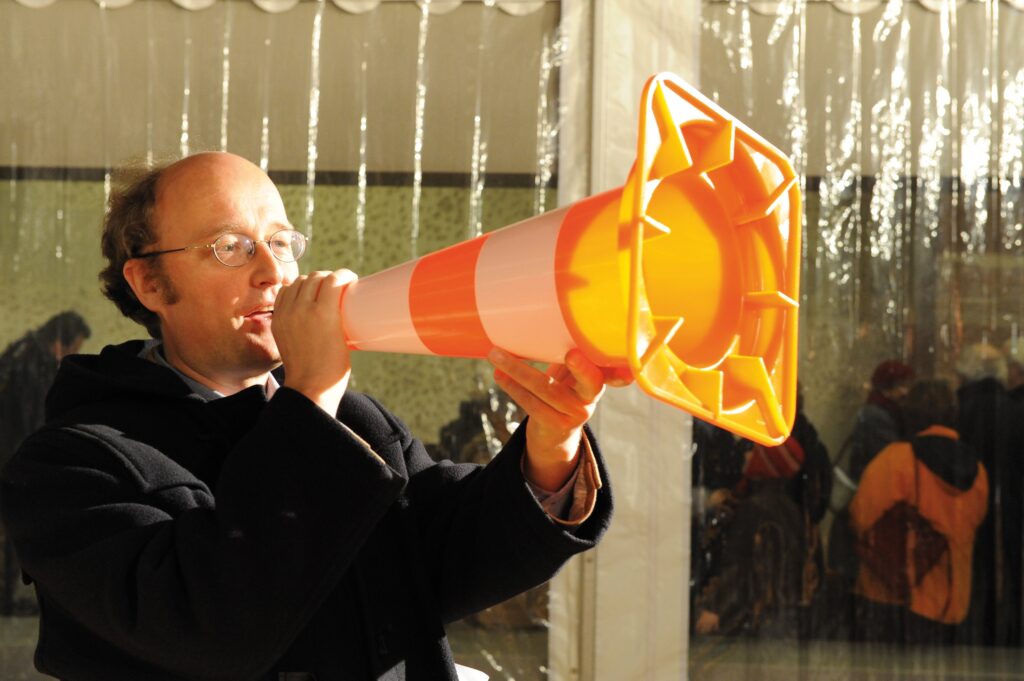
In Basel in particular, a large number of handwritten records of lute music have been preserved, from the possession and mostly the use of well-known Basel families such as Amerbach, Platter, Iselin and Wurstisen. There is also a nice anecdote about the young Felix Platter that when he was caught playing the lute in a tavern in 1551 and was admonished for it, “it would be better if someone else played for him” (it would be better if he learned that others had to play for him), he answered cheekily: “but it’s funny if you can do it yourself”.
What is particularly appealing about the Basel Lute Tour is that the “lute in motion” allows an unusual encounter with this music in otherwise rarely accessible spaces – however, we listeners are allowed to move, while the lutenists have to stay put …
Lay refectory (orphanage area) – Marc Lewon
Five-choir plectrum lute (Richard Earle, Basel 1982):
1. i lament, i lament – Oswald von Wolkenstein (1376-1445)
Intavolation for 5choir plectrum lute: M. Lewon
2. myn trud gheselle – anonymous intavolation of the song “Mein traut geselle
Wolfenbüttel, Niedersächsisches Landesarchiv-Staatsarchiv, Cod. VII B Hs No. 264 (“Wolfenbütteler Lautentabulatur,” Brunswick c1460), fol. Av
3. i far dohin – anonymous
Berlin, State Library of Berlin – Prussian Cultural Heritage, MS Mus.40613 (“Lochamer-Liederbuch,” Nuremberg c1450), p. 9
Ich fare do hyn wen eß muß syn – anonymous intavolation
Wolfenbüttel phonetic tablature, fol. Bv
4. la doulce amour – anonymous Basse danse (Arr. M. Lewon)
Tenor melody: Brussels, Koninklijke Bibliotheek / Bibliothèque royale, MS 9085 (“Dance Booklet of Margaret of Austria”), fol. 20r
Six-course plectrum lute (Stephen Gottlieb, London 2001):
5. the winter wants to give way – anonymous
Lochamer songbook, p. 6-7
6. patientia ognun me dice – Joan Ambrosio Dalza (active around 1508)
Joan Ambrosio Dalza: Intabolatura de lauto libro quarto, Venice: Petrucci (1508), fols.54r-55v
7. de Tossbiens – anonymous arrangement of the chanson “De tous biens plaine” by Hayne van Ghizeghem
Fribourg, Bibliothèque cantonale et universitaire (CH-Fcu), Cap. Rés. 527 (“Lautentabulatur des Peter Falk,” Fribourg c1513), fol. V3 & V6
8. calata ala spagnola – Joan Ambrosio Dalza
Intabolatura de lauto, fol. 50
————————————————————————–
Star Hall (St. Alban Valley, St. Alban-Rheinweg 70) – Bor Zuljan
1. præludium – anonymous
Basel, University Library, F.IX.56, (“Lautentabulatur des Bonifacius Amerbach (1495-1562),” c1521-25), fol. 1r-v
2. fantasia – improvisation
3. passamezzo & saltarello ala Bolognesa – improvisation
4. Fantaisie – Improvisation
5. mille regretz – Josquin des Prez (c1450/55-1521) / Jean Lemaire (c1473-1514) / improvisation
6. Fantaisie – Improvisation
7. a bass – anonymous
Berlin, Staatsbibliothek zu Berlin, Preussischer Kulturbesitz, Musikabteilung, Mus.ms.40588 (“Tabulatur des Salomon Kesler zu Brugg,” 1552), p. 3
8. did you take me – anonymous
Tabulature of Salomon Kesler at Brugg, p. 2
9. Fantaisie – Improvisation
10th Ami souffre que je vous aime – Pierre Moulu (c1484-c1550) / anonymous
Phonetic tablature of Bonifacius Amerbach, fol. 1r
11. the far into the höuw – anonymous
Tabulature of Salomon Kesler at Brugg, p. 4
————————————————————————–
Zunziger Mill (St. Alban Valley 37) – Ziv Braha
Source: Basel, University Library, F.IX.23 (“Tabulatur des Ludwig Iselin (1559-1612)”, 1575)
Seven-chord lute (Mathias Durvie)
1. Exercitium – fol. 6r
2. la Cara Cossa – fol. 16r
3. court tantz [Schwarz Knab] / Nachdantz – fols.13v-14v
4. what we want for the evening / after dinner – fol. 15r-v
5 The day that is so free – fols. 17v-18r
6. galliarda – fol. 17r
7 Joseph, dear Joseph min – fol.18r-18v
8. chi passo per questa strado – fol. 16v
9. rosina tantz / tripla – fol. 19r-v
10 Die meidlein von blofelden tantz / Nachtantz – fols. 20v-21r
11. passo e mezo [moderno] Vngaro – fols. 19v-20r
12. Auß dieffer not – fol. 21v
13. thank the lord – fol. 22r
14. passo e mezo / saltarello sua – fols.23v-25r
————————————————————————–
Rhyblick (orphanage area) – Peter Croton
Main source: Basel, University Library, F.IX.70 (“Tabulatur des Emanuel Wurstisen (1572-1616)”, 1591-95).
Original instrument (Michielle Harton, Padua 1594) restored to a ten-course lute (Johannes Georg Houcken, Erkelenz 1994) and with pasted label: “Josephus Joachimus Edlinger me reparavit Pragæ An: 1736”.
1. preamble – Hans Newsidler (1508-1563)
Hans Newsidler: Ein Newgeordent Künstlich Lautenbuch, In zwen theml getheylt. Der erst fur die anfahenden Schuler, Nürnberg 1536a, fol.s4r
2ndPræludium – Hans Gerle (c1500-1570)
Tablature of Emanuel Wurstisen, p.9d (from: Hans Gerle: Tabulatur auff die Laudten, Nürnberg 1533, fol.9v)
3. passomezo – Wojciech Długoraj (1557/58-after 1619)
Tablature of Emanuel Wurstisen, p.145a (concordance in: Leipzig, Music Library, II.6.15 from 1619)
4. here follows a welscher tantz washa mesa / Der hupff auff – Hans Newsidler
Ein Newgeordent Künstlich Lautenbuch […] Der erst [Teil], fols.t1r-t2r
5. præambulum – anonymous
Tablature of Emanuel Wurstisen, p.13a
6. bella gagliarda – Diomedes Cato (1560/65-1627/28)
Tablature of Emanuel Wurstisen, p.304b
7th volte – Julien Perrichon (1566-c1600)
Tablature of Emanuel Wurstisen, p.283e
8th Fantasia – Matthäus Waissel (c1535/40-1602)
Tablature of Emanuel Wurstisen, p.51
9th Fantasia – Francesco da Milano (1497-1543)
Tablature of Emanuel Wurstisen, p.41a (Arthur J. Ness: The Lute Music of Francesco Canova da Milano, Harvard University Press, Cambridge, Massachusetts 1970; Ness84)
10. fantasia – Francesco da Milano
Ness 51
11. fantasia – Francesco da Milano
Ness40
12 The English Roland (= Lord Willoughby’s Welcome Home)
Tablature of Emanuel Wurstisen, p.331b
13 The flatt paven / Galliard to the Flatt Paven – John Johnson (active 1579-1594)
Cambridge, University Library, Dd 2.11, fols.87r & 1v
The Basel Gesellschaftshaus zum Hohen Dolder at St. Alban Vorstadt 35 is probably the oldest completely preserved Renaissance building in the city. In particular, the paneled hall on the second floor is a gem and popular as a venue for weddings, birthday parties and house concerts.
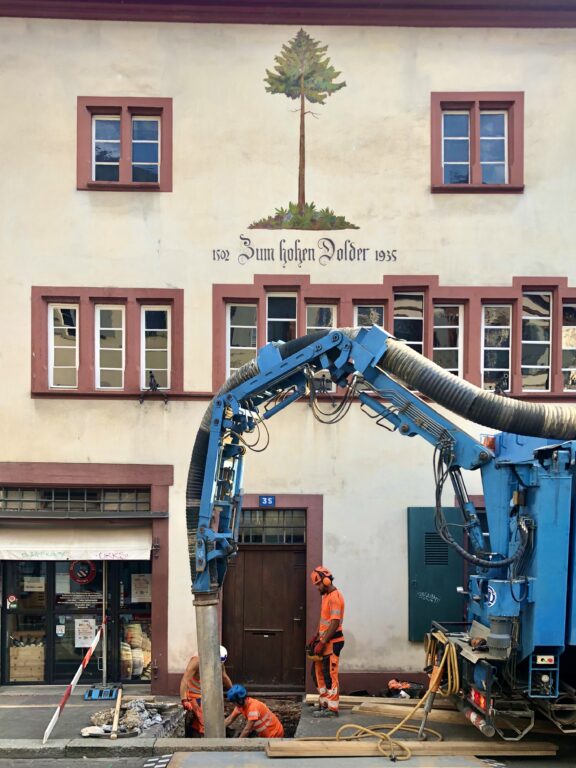
{%CAPTION%}
The house was never a private residence, nor a guild hall, as many assume, but the seat of a suburban society, a kind of neighborhood association, which, however, 500 years ago was endowed by the city with the right of lower jurisdiction.
At that time, the quarter of St. Alban Vorstadt was within the sphere of influence of the St. Alban monastery in the “Dalbeloch”. But when the prior of the monastery could no longer cope with the quarrels and frictions among the suburban residents, he turned to the city council in 1486 to ensure law and order. These were essentially disputes of competence between the people “on the mountain” and those down on the Rhine at the paper mills.
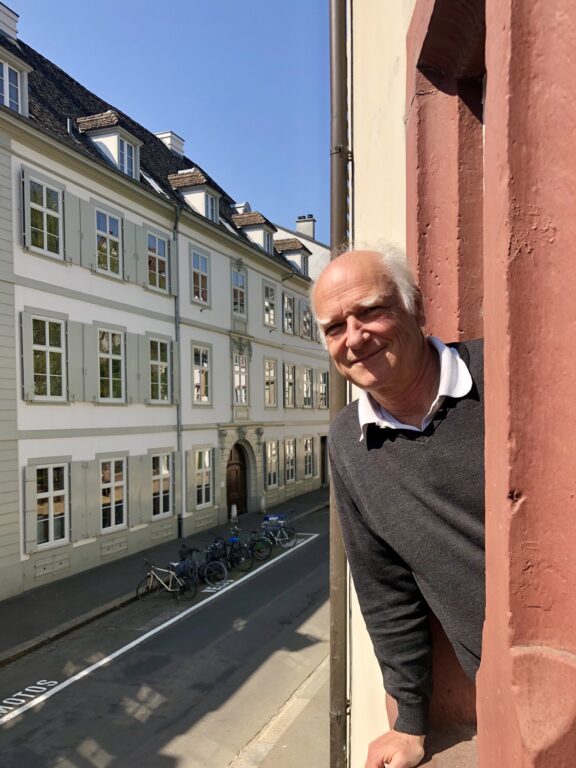
Thomas Christ
It came to the establishment of the first common parlor in the Linden Tower near the monastery. All residents of the neighborhood were compulsory members of the society, which had to be witnessed by a compulsory membership fee. The company, in turn, was obliged to keep the fountains clean, to keep watch on the city walls and to intervene in a warning manner in the event of neighbor disputes.
The parlor of the company served in the 15. and 16th century not only as a meeting place for suburban masters, but also as a temporary inn and a gambling salon. The parlor regulations of 1492 state in particular that it was forbidden under penalty of law to insult others, to beat, to draw knives against fellow journeymen, to throw playing cards out of the window, to break crockery, to gamble on holidays and to swear “wickedly”. At that time, i.e. around 1500, rural life and thus also livestock farming in the suburbs was still pronounced and for many residents a necessary secondary income.
However, the suburban society – at that time called “zum Esel” – did not seem to be very satisfied in the assigned Lindenturm and made every effort to pitch their tents on the mountain. For unexplained reasons, a fire destroyed that tower in 1492, after which the society was able to move into its residence in 1494 in the house at “Tolden”, in today’s St. Alban Vorstadt 35, named after the former owner Johannes zum Tolden.
Initially, the property was rented, but in 1503 it was acquired under hard financing conditions at the expense of the shareholders. Since then, the house has undergone some renovations, but has hardly changed its character significantly.
Worth mentioning, however, is the mural painting from 1547 by the artist Maximilian Wischak, who came from Schaffhausen. On the east wall of the hall, the painting shows Tell’s apple shot”, the “Rütli oath” as well as the “Tell’s leap”, scenes of a founding legend from Central Switzerland, which demonstrably have little to do with the illustrious history of Basel in the 16th century – with Basel as a city of scholars, the pioneers of book printing, where kings and popes frequented.
It is even said to be the first depiction of Tell in Switzerland (a story that only became famous 200 years later through Schiller’s drama).What was the reason for this demonstration of sympathy within Switzerland? As is well known, Basel had decided in 1501 to join the young Swiss Confederation and thus to withdraw, at least politically, from the spheres of influence of the great ruling houses: the mural thus becomes an early Swiss propaganda image.
Barfüsserkirche
Historisches Museum Basel
Barfüsserkirche
Historisches Museum Basel
Barfüsserkirche
Basel Historical Museum
Gold-printed paper calendar